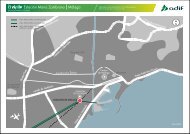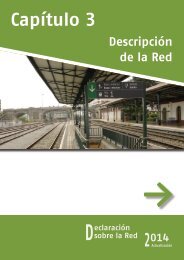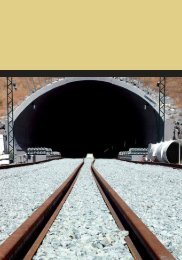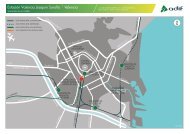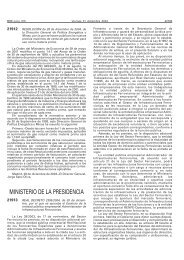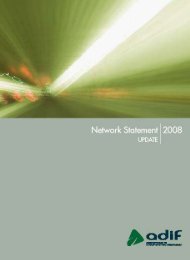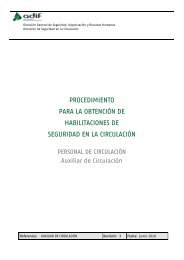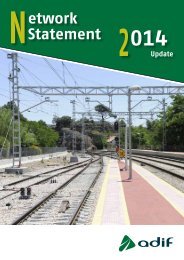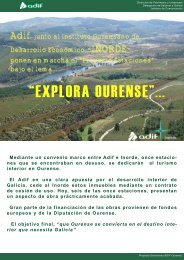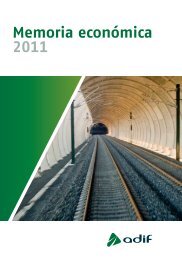Chapter 3 - Adif
Chapter 3 - Adif
Chapter 3 - Adif
Create successful ePaper yourself
Turn your PDF publications into a flip-book with our unique Google optimized e-Paper software.
3.3.2.2. Load Limits<br />
//<br />
Load per Axle and Linear Load<br />
Railway Network of General Interest lines and sections with Iberian gauge managed by <strong>Adif</strong> are classified, for this purpose,<br />
into nine categories, with defining characteristics as shown in the following table, based on the maximum load per axle or per<br />
linear meter.<br />
Type of line<br />
Per Axle<br />
Maximum load<br />
Per Meter<br />
A 16, 0 t 5, 0 t<br />
B1 18, 0 t 5, 0 t<br />
B2 18, 0 t 6, 4 t<br />
C2 20, 0 t 6, 4 t<br />
C3 20, 0 t 7, 2 t<br />
C4 20, 0 t 8, 0 t<br />
D2 22, 5 t 6, 4 t<br />
D3 22, 5 t 7, 2 t<br />
D4 22, 5 t 8, 0 t<br />
At present most of the lines of the Network Managed by <strong>Adif</strong> are Category D4. There are, however, some specific restrictions<br />
affecting certain points and lines, which can be consulted on the Operating Manual.<br />
On meter-gauge lines, maximum axle load is 15.0 t and per linear meter is 8.0 t.<br />
//<br />
Towable Load Limit<br />
The “Table of Maximum Loads” is the official document<br />
that lays down towable loads, for each locomotive and for<br />
different lines on the Network. It is available to RUs and other<br />
Applicants in the Department for Capacity Management<br />
and Planning reporting to the Department of Planning and<br />
Network Management.<br />
In general, the maximum load is determined on the basis of<br />
considering two parameters:<br />
♦♦<br />
♦♦<br />
The characteristic worst gradient on the train route.<br />
The maximum load of the locomotives, depending on<br />
the characteristics of afore gradient.<br />
Maximum load represents the load that a locomotive can<br />
technically carry if operating in extreme conditions.<br />
The application of the maximum load to trains can result,<br />
especially in case of diesel locomotives, in low traffic speeds<br />
which may prove to be incompatible with exploitation<br />
or with a reasonable use of track capacity. Therefore,<br />
regardless of the maximum load established, <strong>Adif</strong> may set<br />
conditions or reject applications that result in unsuitable<br />
speeds due to the load given by Applicants for a particular<br />
request for Capacity.<br />
3.3.2.3. Characteristic Line Gradients<br />
Maps 7 and 7.1 of Annex H show characteristic line gradients<br />
on the rail network most important sections, for both<br />
running directions.<br />
3.3.2.4. Maximum Speeds<br />
//<br />
Types of Rolling Stock<br />
For speed limits purposes, the rolling stock is classified by<br />
types, in relation to the following determinants:<br />
♦♦<br />
♦♦<br />
The maximum authorized speed for each vehicle.<br />
Acceleration without compensation admitted by<br />
vehicles, according to the following five classes<br />
considered:<br />
TYPES N A B C D<br />
Acceleration (m / s 2 ) 0, 65 1 1, 2 1, 5 1, 8<br />
The resulting train type shall correspond to the worst “Type” for any vehicle in the train set.<br />
46<br />
Network Statement Update 2014 V.0



